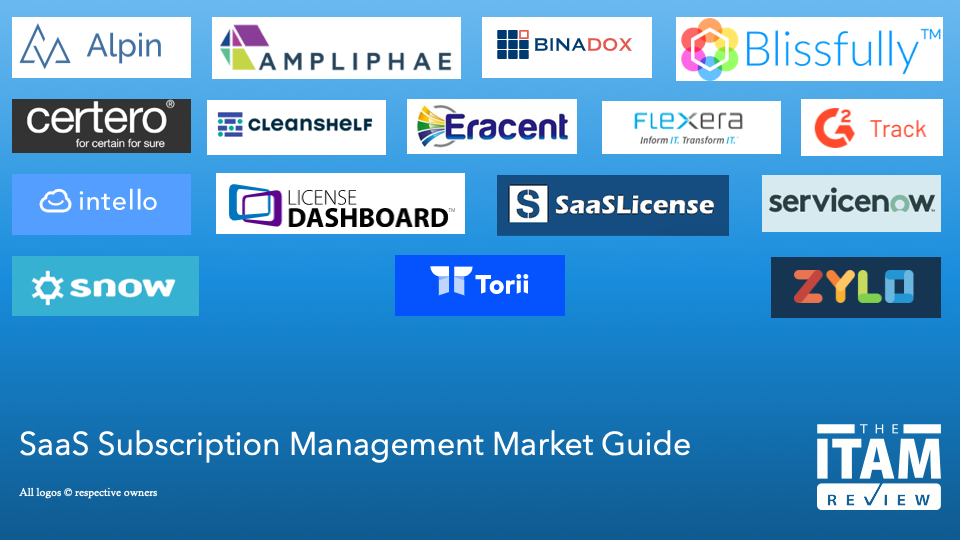SaaS Subscription Optimisation – Market Trends
This month’s Market Guide is an update to the guide to the SaaS Optimisation market published in July 2018. That guide indicated that the market was nascent and rapidly evolving, and that’s backed up by the trends we’ve seen since then.
Moving beyond a focus on cost
2019 has seen tools pivot to deliver benefits in addition to cost management. Common themes are Governance, Security & Risk Management, Automation, and Vendor Management. In doing this, many tools are now able to provide a greater degree of confidence about a SaaS estate, through improved discovery & inventory.
Adding discovery capabilities
In 2018 I highlighted the difficulties around effective and reliable SaaS discovery and inventory1. This year’s guide shows that whilst most tools leverage the same set of core techniques – APIs, Finance integrations, and SSO – there is still room for innovative approaches. We now see web browser extensions and web proxy integrations being provided, along with some agent-based discovery.
Governance, Security, Risk & Compliance
I’ve argued that moving beyond cost management is essential to delivering continuing ROI from your SaaS Subscription Optimisation tools2. The regulatory landscape is getting tougher and hitting the bottom-line, and 2019 has seen the first large proposed fines for breaches under the GDPR3. Most of the tools in the guide claim capabilities relating to governance, risk, and compliance. These range from recording the regulatory certifications of SaaS services (e.g. SOC24) to keeping a system of record for regulations such as the GDPR.
Automation
A criticism that could be made of the original iterations of many of these tools was that the insights they provided often weren’t actionable. The dashboards may have looked good but there was a lot of heavy lifting to be done behind the scenes to deliver the optimisations identified by the tool. 2019 has seen the debut of automation workflows for many tools – enabling, for example, the automatic provisioning and de-provisioning of SaaS apps for new hires and leavers.
Vendor Management
Many tools now offer improved capabilities for vendor management. Functionality includes renewal calendaring (available in most tools) and more innovative approaches such as price benchmarking. Data-driven vendor management has the potential to drive cost-effectiveness by providing certainty to procurement professionals with regard to deployment and intent. Price benchmarking, available in some tools, can help drive a better deal at renewal time.
Enterprise-Ready
Many tools were themselves SaaS startups, seeking to help SaaS-first organisations to manage their spending. This was reflected in often rapid onboarding, freemium pricing models, and the rapid feature delivery so familiar from startups. 2019 has seen some tool providers call out their enterprise-ready features such as user profiling, fine-grained access controls, and department or cost-centre level views that are particularly beneficial for larger organisations.
Traditional ITAM toolsets catch up
In the original Market Guide, I highlighted how many of the included tools had stolen a march on “traditional” ITAM vendors. 2019 has seen this change with most vendors having enhanced their SaaS Subscription Optimisation capabilities. This has been through the release of new versions (Snow) or the integration of acquisitions such as VendorHawk (ServiceNow), MetaSaaS (Flexera), and Siftery (G2 Crowd).
New entrants
Possibly this is a further sign of market maturity; I’ve identified just two new fully-featured entrants to the market since the last guide. These are Ampliphae & SaaSLicense. As noted above, Siftery was acquired by G2 Crowd in late-2018. However, I would expect this relatively static position to change in 2020. Funding doesn’t last forever and as we head into year 3/4 for most of these startups there will either be a dash for scale in order to survive, or the hope of an exit via acquisition. The ITAM market as a whole is seeing a wave of new entrants, consolidations, and potential acquisitions, and this may have an impact on this market. Players from the Security & Network Management arenas such as Qualys & SolarWinds may disrupt the status quo.
Buying a SaaS Subscription Management toolset
As noted above, there is still considerably more differentiation between products in this market in comparison to the traditional ITAM market. In order to select the right tool buyers should evaluate first what potential use cases are important to their organisation, and also delve into the detail of these tools. The feature differentiation makes effective shortlisting through a robust RFI process important in order to ensure you invest in the right tool. To help you with this we have produced a guide – “What to look for in a SaaS Subscription Optimisation Tool”
CLICK HERE TO ACCESS THE MARKET GUIDE
References
- SaaS tool inventory – solving the Inventory & Discovery challenge. ITAM Rev. June 2018. https://marketplace.itassetmanagement.net/2018/06/07/saas-applications-solving-the-inventory-discovery-challenge/. Accessed August 16, 2019.
- SaaS Application Management – should risk be prioritised over cost? ITAM Rev. August 2018. https://marketplace.itassetmanagement.net/2018/08/23/saas-application-risk-management/. Accessed August 21, 2019.
- Sweney M. BA faces £183m fine over passenger data breach. The Guardian. https://www.theguardian.com/business/2019/jul/08/ba-fine-customer-data-breach-british-airways. Published July 8, 2019. Accessed August 15, 2019.
- SSAE 16. In: Wikipedia. ; 2019. https://en.wikipedia.org/w/index.php?title=SSAE_16&oldid=898377216. Accessed August 19, 2019.
- Tags: Alpin · Ampliphae · Binadox · Blissfully · certero · Cleanshelf · Cloud Cost Management · Eracent · Flexera · G2 Track · Intello · license dashboard · SaaS optimisation · SaaS subscription management · SaaSLicense · ServiceNow · Snow · Torii · Zylo


As someone in the space, it’s worth pointing out License Management is a big ask from organizations for two reasons.
1) Wasted licenses is a major budget burner.
2) Managing who is using which license is a major IT time drainer.